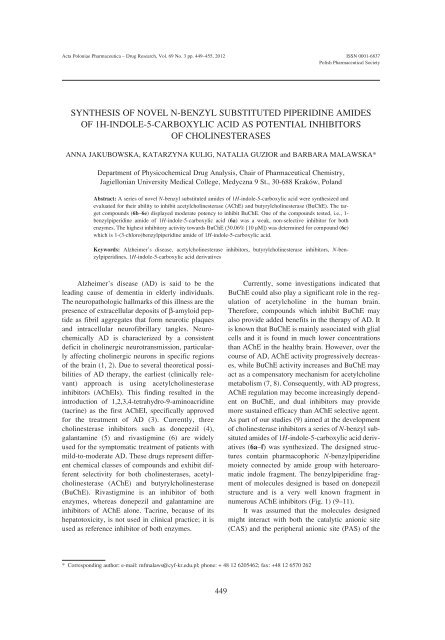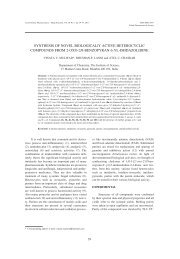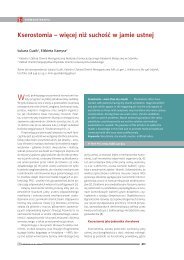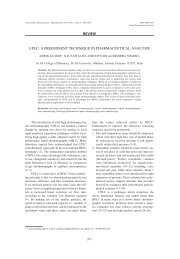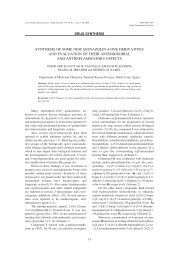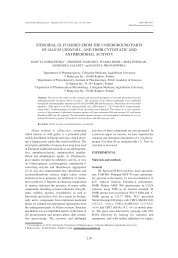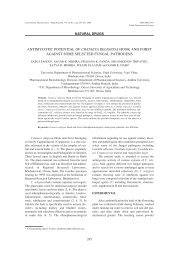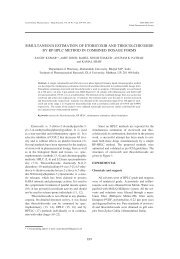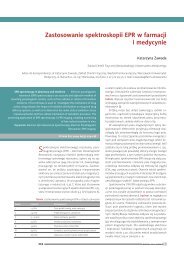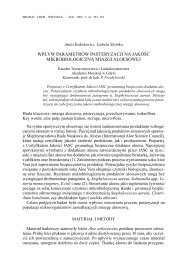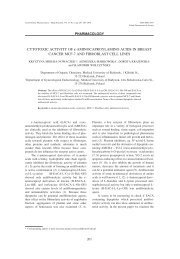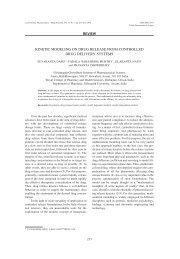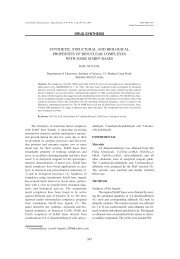Synthesis of novel N-benzyl substituted piperidine amides of 1H
Synthesis of novel N-benzyl substituted piperidine amides of 1H
Synthesis of novel N-benzyl substituted piperidine amides of 1H
Create successful ePaper yourself
Turn your PDF publications into a flip-book with our unique Google optimized e-Paper software.
Acta Poloniae Pharmaceutica ñ Drug Research, Vol. 69 No. 3 pp. 449ñ455, 2012 ISSN 0001-6837<br />
Polish Pharmaceutical Society<br />
SYNTHESIS OF NOVEL N-BENZYL SUBSTITUTED PIPERIDINE AMIDES<br />
OF <strong>1H</strong>-INDOLE-5-CARBOXYLIC ACID AS POTENTIAL INHIBITORS<br />
OF CHOLINESTERASES<br />
ANNA JAKUBOWSKA, KATARZYNA KULIG, NATALIA GUZIOR and BARBARA MALAWSKA*<br />
Department <strong>of</strong> Physicochemical Drug Analysis, Chair <strong>of</strong> Pharmaceutical Chemistry,<br />
Jagiellonian University Medical College, Medyczna 9 St., 30-688 KrakÛw, Poland<br />
Abstract: A series <strong>of</strong> <strong>novel</strong> N-<strong>benzyl</strong> <strong>substituted</strong> <strong>amides</strong> <strong>of</strong> <strong>1H</strong>-indole-5-carboxylic acid were synthesized and<br />
evaluated for their ability to inhibit acetylcholinesterase (AChE) and butyrylcholinesterase (BuChE). The target<br />
compounds (6bñ6e) displayed moderate potency to inhibit BuChE. One <strong>of</strong> the compounds tested, i.e., 1<strong>benzyl</strong><strong>piperidine</strong><br />
amide <strong>of</strong> <strong>1H</strong>-indole-5-carboxylic acid (6a) was a weak, non-selective inhibitor for both<br />
enzymes. The highest inhibitory activity towards BuChE (30.06% [10 µM]) was determined for compound (6c)<br />
which is 1-(3-chloro)<strong>benzyl</strong><strong>piperidine</strong> amide <strong>of</strong> <strong>1H</strong>-indole-5-carboxylic acid.<br />
Keywords: Alzheimerís disease, acetylcholinesterase inhibitors, butyrylcholinesterase inhibitors, N-<strong>benzyl</strong><strong>piperidine</strong>s,<br />
<strong>1H</strong>-indole-5-carboxylic acid derivatives<br />
Alzheimerís disease (AD) is said to be the<br />
leading cause <strong>of</strong> dementia in elderly individuals.<br />
The neuropathologic hallmarks <strong>of</strong> this illness are the<br />
presence <strong>of</strong> extracellular deposits <strong>of</strong> β-amyloid peptide<br />
as fibril aggregates that form neurotic plaques<br />
and intracellular neur<strong>of</strong>ibrillary tangles. Neurochemically<br />
AD is characterized by a consistent<br />
deficit in cholinergic neurotransmission, particularly<br />
affecting cholinergic neurons in specific regions<br />
<strong>of</strong> the brain (1, 2). Due to several theoretical possibilities<br />
<strong>of</strong> AD therapy, the earliest (clinically relevant)<br />
approach is using acetylcholinesterase<br />
inhibitors (AChEIs). This finding resulted in the<br />
introduction <strong>of</strong> 1,2,3,4-tetrahydro-9-aminoacridine<br />
(tacrine) as the first AChEI, specifically approved<br />
for the treatment <strong>of</strong> AD (3). Currently, three<br />
cholinesterase inhibitors such as donepezil (4),<br />
galantamine (5) and rivastigmine (6) are widely<br />
used for the symptomatic treatment <strong>of</strong> patients with<br />
mild-to-moderate AD. These drugs represent different<br />
chemical classes <strong>of</strong> compounds and exhibit different<br />
selectivity for both cholinesterases, acetylcholinesterase<br />
(AChE) and butyrylcholinesterase<br />
(BuChE). Rivastigmine is an inhibitor <strong>of</strong> both<br />
enzymes, whereas donepezil and galantamine are<br />
inhibitors <strong>of</strong> AChE alone. Tacrine, because <strong>of</strong> its<br />
hepatotoxicity, is not used in clinical practice; it is<br />
used as reference inhibitor <strong>of</strong> both enzymes.<br />
449<br />
Currently, some investigations indicated that<br />
BuChE could also play a significant role in the regulation<br />
<strong>of</strong> acetylcholine in the human brain.<br />
Therefore, compounds which inhibit BuChE may<br />
also provide added benefits in the therapy <strong>of</strong> AD. It<br />
is known that BuChE is mainly associated with glial<br />
cells and it is found in much lower concentrations<br />
than AChE in the healthy brain. However, over the<br />
course <strong>of</strong> AD, AChE activity progressively decreases,<br />
while BuChE activity increases and BuChE may<br />
act as a compensatory mechanism for acetylcholine<br />
metabolism (7, 8). Consequently, with AD progress,<br />
AChE regulation may become increasingly dependent<br />
on BuChE, and dual inhibitors may provide<br />
more sustained efficacy than AChE selective agent.<br />
As part <strong>of</strong> our studies (9) aimed at the development<br />
<strong>of</strong> cholinesterase inhibitors a series <strong>of</strong> N-<strong>benzyl</strong> subsituted<br />
<strong>amides</strong> <strong>of</strong> <strong>1H</strong>-indole-5-carboxylic acid derivatives<br />
(6añf) was synthesized. The designed structures<br />
contain pharmacophoric N-<strong>benzyl</strong><strong>piperidine</strong><br />
moiety connected by amide group with heteroaromatic<br />
indole fragment. The <strong>benzyl</strong><strong>piperidine</strong> fragment<br />
<strong>of</strong> molecules designed is based on donepezil<br />
structure and is a very well known fragment in<br />
numerous AChE inhibitors (Fig. 1) (9ñ11).<br />
It was assumed that the molecules designed<br />
might interact with both the catalytic anionic site<br />
(CAS) and the peripheral anionic site (PAS) <strong>of</strong> the<br />
* Corresponding author: e-mail: mfmalaws@cyf-kr.edu.pl; phone: + 48 12 6205462; fax: +48 12 6570 262
450 ANNA JAKUBOWSKA et al.<br />
Figure 1. Donepezil and AChE inhibitors (4, 9ñ11)<br />
Figure 2. Schematic structure <strong>of</strong> compounds design<br />
enzyme. In the present study, the synthesis <strong>of</strong> new<br />
N-<strong>benzyl</strong> <strong>substituted</strong> <strong>piperidine</strong> <strong>amides</strong> <strong>of</strong> <strong>1H</strong>indole-5-carboxylic<br />
acid and their in vitro biological<br />
evaluation towards AChE and BuChE inhibitions is<br />
described (Fig. 2).<br />
EXPERIMENTAL<br />
Chemistry<br />
As a starting material for the synthesis the final<br />
<strong>amides</strong>, piperidin-4-ol (1) was chosen. In the first<br />
step, compound (1) reacted under the phase transfer<br />
catalysis conditions with appropriate <strong>substituted</strong><br />
<strong>benzyl</strong>bromide derivatives (2añf), giving relevant<br />
N-<strong>benzyl</strong>piperidin-4-ol derivatives (3añf) with good<br />
to excellent (72ñ99%) yields. These reactions were<br />
carried out in the mixture <strong>of</strong> acetonitrile, K 2CO 3 and<br />
tetrabutylammonium iodide. In the next step, the<br />
obtained alcohols (3añf) were transformed into relevant<br />
<strong>substituted</strong> 2-(1-<strong>benzyl</strong>piperidin-4-yl)isoindoline-1,3-dione<br />
derivatives (4añf) in the Mitsunobu<br />
reaction (12), which was carried out in dry THF
<strong>Synthesis</strong> <strong>of</strong> <strong>novel</strong> N-<strong>benzyl</strong> <strong>substituted</strong> <strong>piperidine</strong> <strong>amides</strong> <strong>of</strong> <strong>1H</strong>-indole-5-carboxylic acid... 451<br />
using phtalimide, triphenylphosphine (Ph 3P) and<br />
diisopropylazodicarboxylate (DIAD) under argon<br />
atmosphere. The yields <strong>of</strong> this process were rather<br />
low between 17 and 31%. Hydrazinolysis <strong>of</strong> compounds<br />
(4añf) gave primary amines (5añf), which<br />
have been used for further synthesis without purification.<br />
Finally, the commercially available <strong>1H</strong>indole-5-carboxylic<br />
acid was activated with carbonyldiimidazole<br />
(CDI) and reacted with the appropriate<br />
amine (5añf) in dry THF (13) giving the final<br />
compounds (6añf) with low to good yield (6c)<br />
(25ñ85%). The structures <strong>of</strong> the new compounds<br />
were confirmed by elemental analysis and spectral<br />
data ( 1 H NMR, MS), their purity by thin layer chromatography.<br />
Reagents and solvents were purchased from<br />
common commercial suppliers, and were used without<br />
further purification. All experiments, in which<br />
air-sensitive materials were used, were carried out in<br />
oven-dried glassware under a dry argon atmosphere.<br />
Standard vacuum techniques were used for handling<br />
air-sensitive materials. Tetrahydr<strong>of</strong>uran (THF) was<br />
dried, kept under argon and freshly distilled over<br />
sodium-benzophenone before use. Melting points<br />
were determined in open capillaries on an<br />
Electrothermal 9300 apparatus and are uncorrected.<br />
Merck silica gel 60 (70ñ230 mesh ASTM) was used<br />
for column chromatography. As solvents for chromatography<br />
mixtures: S 1 dichloromethane/methanol<br />
(9:1), S 2 dichloromethane/methanol (95:5), S 3 acetone,<br />
were used. Analytical thin layer chromatography<br />
was performed on Merck TLC plates, silica gel<br />
60 F 254. TLC visualization was achieved with a UV<br />
lamp or ninhydrin solution (0.3% ninhydrin in n-<br />
BuOH with 3% AcOH). Nuclear magnetic resonance<br />
spectra ( 1 H NMR) were recorded with Varian<br />
Mercury VX 300 MHz (Hansen Way, USA) spectrometer<br />
using CDCl 3 or DMSO-d 6 at ambient temperature<br />
using the solvent signal as an internal standard.<br />
The chemical shifts (δ) are reported in parts<br />
per million (ppm). In the case <strong>of</strong> solid products elemental<br />
analyses were performed on Vario EL III<br />
Elemental analyzer (Elementar Analysensystem,<br />
Hanau, Germany). Mass spectras were recorded on<br />
Waters Acquity TQD spectrometer (Waters, USA).<br />
Mass spectra were obtained by electronic impact<br />
(EI) at 70 eV.<br />
General procedure for the synthesis <strong>of</strong> compounds<br />
3añf<br />
Piperidin-4-ol (1) (2.03 g, 20 mmol) and relevant<br />
<strong>benzyl</strong>bromide derivatives (2añf) (20 mmol)<br />
were dissolved in 20 mL <strong>of</strong> acetonitrile. Then, anhydrous<br />
K 2CO 3 (2.76 g, 20 mmol) and TBAI (0.08 g,<br />
0.2 mmol) were added. The reaction mixture was<br />
refluxed for 24 h. The inorganic salt was filtered and<br />
washed with methanol. The filtrate was evaporated<br />
and the oil obtained was purified by column chromatography<br />
using a mixture <strong>of</strong> dichloromethane/<br />
methanol (9:1).<br />
1-Benzylpiperidin-4-ol (3a)<br />
Yellow oil. Yield: 72%; TLC: R f = 0.36 (S 1);<br />
1 H NMR (CDCl3, δ, ppm): 1.22 (s, CHOH, <strong>1H</strong>),<br />
1.51ñ1.69 (m, piper, 2H), 1.82ñ1.95 (m, piper, 2H),<br />
2.09ñ2.22 (m, piper, 2H), 2.69ñ2.82 (m, piper, 2H),<br />
3.51 (s, NCH 2, 2H), 3.62ñ3.77 (m, CHOH, <strong>1H</strong>),<br />
7.19ñ7.36 (m, arom, 5H).<br />
1-(3-Bromo)<strong>benzyl</strong>piperidin-4-ol (3b)<br />
Yellow oil. Yield: 99%; TLC: R f = 0.50 (S 1);<br />
1 H NMR (CDCl3, δ, ppm): 1.49ñ1.68 (m, CHOH,<br />
piper, 3H), 1.80ñ1.94 (m, piper, 2H), 2.07ñ2.21 (m,<br />
piper, 2H), 2.66ñ2.79 (m, piper, 2H), 3.47 (s, NCH 2,<br />
2H), 3.64ñ3.75 (m, CHOH, <strong>1H</strong>), 7.12ñ7.50 (m,<br />
arom, 4H).<br />
1-(3-Chloro)<strong>benzyl</strong>piperidin-4-ol (3c)<br />
Yellow oil. Yield: 90%; TLC: R f = 0.41 (S 1);<br />
1 H NMR (CDCl3, δ, ppm): 1.50ñ1.70 (m, CHOH,<br />
piper, 3H), 1.82ñ1.94 (m, piper, 2H), 2.08ñ2.22 (m,<br />
piper, 2H), 2.67ñ2.79 (m, piper, 2H), 3.47 (s, NCH 2,<br />
2H), 3.63ñ3.76 (m, CHOH, <strong>1H</strong>), 7.14ñ7.35 (m,<br />
arom, 4H).<br />
1-(3-Fluoro)<strong>benzyl</strong>piperidin-4-ol (3d)<br />
Yellow oil. Yield: 86%; TLC: R f = 0.46 (S 1);<br />
1 H NMR (CDCl3, δ, ppm): 1.51ñ1.68 (m, piper, 2H),<br />
1.82ñ1.96 (m, CHOH, piper, 3H), 2.10ñ2.23 (m,<br />
piper, 2H), 2.68ñ2.80 (m, piper, 2H), 3.49 (s, NCH 2,<br />
2H), 3.62ñ3.77 (m, CHOH, <strong>1H</strong>), 6.88ñ7.31 (m,<br />
arom, 4H).<br />
1-(3-Methoxy)<strong>benzyl</strong>piperidin-4-ol (3e)<br />
Yellow oil. Yield: 98%; TLC: R f = 0.20 (S 1);<br />
1 H NMR (CDCl3, δ, ppm): 1.51ñ1.67 (m, CHOH,<br />
piper, 3H), 1.82ñ1.94 (m, piper, 2H), 2.09ñ2.24 (m,<br />
piper, 2H), 2.69ñ2.83 (m, piper, 2H), 3.48 (s, NCH 2<br />
arom, 2H), 3.64ñ3.75 (m, CHOH, <strong>1H</strong>), 3.80 (s,<br />
OCH 3, 3H), 6.75ñ7.28 (m, arom, 4H).<br />
1-(4-Bromo)<strong>benzyl</strong>piperidin-4-ol (3f)<br />
Yellow oil. Yield: 98%; TLC: R f = 0.40 (S 1);<br />
1 H NMR (CDCl3, δ, ppm): 1.49ñ1.73 (m, CHOH,<br />
piper, 3H), 1.80ñ1.94 (m, piper, 2H), 2.07ñ2.21 (m,<br />
piper, 2H), 2.66ñ2.77 (m, piper, 2H), 3.47 (s, NCH 2,<br />
2H), 3.62ñ3.77 (m, CHOH, <strong>1H</strong>), 7.14ñ7.48 (m,<br />
arom, 4H).
452 ANNA JAKUBOWSKA et al.<br />
General procedure for the synthesis <strong>of</strong> compounds<br />
4añf<br />
To the stirred solution <strong>of</strong> Ph 3P (6.4 g, 24 mmol)<br />
in dry THF (150 mL), maintained at 0 O C under an<br />
atmosphere <strong>of</strong> dry argon, DIAD (4.4 g, 20 mmol)<br />
was added dropwise. The resulting solution was<br />
stirred at the same temperature for 20 min whereupon<br />
it showed a creamy white color. Then, relevant<br />
1-<strong>benzyl</strong>piperidin-4-ol (3añf) (20 mmol) dissolved<br />
in THF (26 mL) was added dropwise. Finally,<br />
phthalimide (3.28 g, 20 mmol) was added in one<br />
portion. The resulting mixture was stirred at 0 O C for<br />
another 20 min and then for 72 h at room temperature.<br />
The solvent was removed in vacuum. Diethyl<br />
ether was added to the residue to precipitate triphenylphosphine<br />
oxide, which was filtered <strong>of</strong>f after 24 h.<br />
The filtrate was evaporated, and toluene was added<br />
to the residue to precipitate diisopropyl hydrazinedicarboxylate.<br />
The obtained precipitate was filtered<br />
<strong>of</strong>f after 48 h. The filtrate was evaporated, and the<br />
product was purified by crystallization from<br />
methanol.<br />
2-(1-Benzylpiperidin-4-yl)isoindoline-1,3-dione<br />
(4a)<br />
White crystals. Yield: 23%; m.p. 157ñ158 O C,<br />
lit. 156ñ157 O C (14); Analysis: calcd. for C 20H 20N 2O 2:<br />
C 74.98, H 6.29, N 8.74%; found: C 74.90, H 5.30,<br />
N 8.76%; TLC: R f = 0.78 (S 2); MS (m/z): 321<br />
[M+H] + ; 1 H NMR (CDCl 3, δ, ppm): 1.55ñ1.71 (m,<br />
piper, 2H), 2.04ñ2.16 (m, piper, 2H), 2.48ñ2.65 (m,<br />
piper, 2H), 2.95ñ3.06 (m, piper, 2H), 3.56 (s, NCH 2,<br />
2H), 4.06ñ4.12 (m, CHOH, <strong>1H</strong>), 7.22ñ7.40 (m,<br />
arom, 3H), 7.66ñ7.91 (m, arom, 6H).<br />
2-[1-(3-Bromo)<strong>benzyl</strong>piperidin-4-yl]isoindoline-<br />
1,3-dione (4b)<br />
White crystals. Yield: 22%; m.p. 108ñ113 O C;<br />
Analysis: calcd. for C 20H 19N 2O 2Br: C 60.16, H 4.80,<br />
N 7.02%; found: C 60.10, H 4.82, N 7.06%; TLC:<br />
R f: = 0.88 (S 2); MS (m/z): 399 [M+H] + ; 1 H NMR<br />
(CDCl 3, δ, ppm): 1.57ñ1.73 (m, piper, 2H),<br />
2.04ñ2.17 (m, piper, 2H), 2.48ñ2.65 (m, piper, 2H),<br />
2.92ñ3.03 (m, piper, 2H), 3.51 (s, NCH 2, 2H),<br />
4.06ñ4.20 (m, CHOH, <strong>1H</strong>), 7.14ñ7.42 (m, arom,<br />
4H), 7.65ñ7.86 (m, arom, 4H).<br />
2-[1-(3-Chloro)<strong>benzyl</strong>piperidin-4-yl]isoindoline-<br />
1,3-dione (4c)<br />
White crystals. Yield: 31%; m.p. 96ñ99 O C;<br />
Analysis: calcd. for C 20H 19N 2O 2Cl: C 67.70, H 5.40,<br />
N 7.89%; found: C 67.74, H 5.43, N 7.86%; TLC: R f<br />
= 0.95 (S 2); MS (m/z): 355 [M+H] + ; 1 H NMR<br />
(CDCl 3, δ, ppm): 1.60ñ1.77 (m, piper, 2H),<br />
2.04ñ2.18 (m, piper, 2H), 2.48ñ2.66 (m, piper, 2H),<br />
2.93ñ3.04 (m, piper, 2H), 3.52 (s, NCH 2, 2H),<br />
4.06ñ4.20 (m, CHOH, <strong>1H</strong>), 7.20ñ7.40 (m, arom,<br />
4H), 7.63ñ7.88 (m, arom, 4H).<br />
2-[1-(3-Fluoro)<strong>benzyl</strong>piperidin-4-yl]isoindoline-<br />
1,3-dione (4d)<br />
White crystals. Yield: 17%; m.p. 99 O C; TLC:<br />
R f = 0.90 (S 2); Analysis: calcd. for C 20H 19N 2O 2F: C<br />
70.99, H 5.66, N 8.25%; found: C 70.90, H 5.62, N<br />
8.26%; MS (m/z): 339 [M+H] + ; 1 H NMR (CDCl 3, δ,<br />
ppm): 1.59ñ1.76 (m, piper, 2H), 2.04ñ2.18 (m,<br />
piper, 2H), 2.48ñ2.65 (m, piper, 2H), 2.93ñ3.04 (m,<br />
piper, 2H), 3.54 (s, NCH 2, 2H), 4.06ñ4.21 (m,<br />
CHOH, <strong>1H</strong>), 6.89ñ7.33 (m, arom, 2H), 7.65ñ7.87<br />
(m, arom, 6H).<br />
2-[1-(3-Methoxy)<strong>benzyl</strong>piperidin-4-yl]isoindoline-1,3-dione<br />
(4e)<br />
White crystals. Yield: 22%; m.p. 131 O C.<br />
Analysis: calcd. for C 2<strong>1H</strong> 22N 2O 3: C 71.98, H 6.33, N<br />
7.99%; found: C 71.91, H 6.23, N 7.92%; TLC: R f =<br />
0.67 (S 2); MS (m/z): 351 [M+H] + ; 1 H NMR (CDCl 3,<br />
δ, ppm): 1.58ñ1.75 (m, piper, 2H), 2.04ñ2.18 (m,<br />
piper, 2H), 2.48ñ2.66 (m, piper, 2H), 2.95ñ3.07 (m,<br />
piper, 2H), 3.53 (s, NCH 2, 2H), 3.83 (s, OCH 3, 3H),<br />
4.05ñ4.20 (m, CHOH, <strong>1H</strong>), 6.76ñ7.29 (m, arom,<br />
4H), 7.65ñ7.88 (m, arom, 4H).<br />
2-[1-(4-Bromo)<strong>benzyl</strong>piperidin-4-yl]isoindoline-<br />
1,3-dione (4f)<br />
White crystals. Yield: 30%; m.p. 131 O C;<br />
Analysis: calcd. for C 20H 19BrN 2O 2: C 60.16, H 4.80,<br />
N 7.02%; found: C 60.18, H 4.70, N 7.01%; TLC: R f<br />
= 0.82 (S 2); MS (m/z): 399 [M+H] + ; 1 H NMR<br />
(CDCl 3, δ, ppm): 1.55ñ1.71 (m, piper, 2H),<br />
2.02ñ2.14 (m, piper, 2H), 2.47ñ2.64 (m, piper, 2H),<br />
2.91ñ3.02 (m, piper, 2H), 3.49 (s, NCH 2, arom, 2H),<br />
4.06ñ4.19 (m, CHOH, <strong>1H</strong>), 7.21ñ7.48 (m, aromat,<br />
2H), 7.66-7.88 (m, aromat, 6H).<br />
General procedure for the synthesis <strong>of</strong> compounds<br />
5a-f<br />
To a stirred solution <strong>of</strong> various <strong>substituted</strong> 2-<br />
(1-<strong>benzyl</strong>piperidin-4-yl)isoindoline-1,3-diones<br />
(4a-f) (3 mmol) in methanol (60 mL) hydrazine<br />
hydrate (3 g, 60 mmol) was added dropwise. The<br />
resulting mixture was stirred at room temperature<br />
for 24 h. Then, the obtained white precipitate was<br />
filtered <strong>of</strong>f and washed with methanol. The filtrate<br />
was evaporated, and the remaining oil was dissolved<br />
in water (60 mL) and extracted with dichloromethane<br />
(3 ◊ 60 mL). The combined organic layers were<br />
dried over Na 2SO 4, filtered, and concentrated in vac-
<strong>Synthesis</strong> <strong>of</strong> <strong>novel</strong> N-<strong>benzyl</strong> <strong>substituted</strong> <strong>piperidine</strong> <strong>amides</strong> <strong>of</strong> <strong>1H</strong>-indole-5-carboxylic acid... 453<br />
uum. The obtained oil was used in further synthesis<br />
without purification.<br />
General procedure for the synthesis <strong>of</strong> compounds<br />
6añf<br />
CDI (1 eq.) was added to a solution <strong>of</strong> <strong>1H</strong>indole-5-carboxylic<br />
acid (1 eq. for compounds 5añc<br />
or 1.5 eq for compounds 5dñf) in dry THF under an<br />
atmosphere <strong>of</strong> dry argon. Thirty minutes later, various<br />
<strong>substituted</strong> 4-amine-1-<strong>benzyl</strong><strong>piperidine</strong>s (5añf)<br />
(1 eq.) dissolved in THF were added, and the reaction<br />
mixture was stirred at room temperature for 24<br />
h. Then, the solvent was removed in vacuum and the<br />
oil obtained was purified by column chromatography<br />
using an acetone as a solvent.<br />
<strong>1H</strong>-indole-5-carboxylic acid (1-<strong>benzyl</strong>piperidin-<br />
4-yl)-amide (6a)<br />
Reagents: 4-amine-1-<strong>benzyl</strong><strong>piperidine</strong> (0.38 g,<br />
2 mmol), <strong>1H</strong>-indole-5-carboxylic acid (0.32 g, 2<br />
mmol), CDI (0.32 g, 2 mmol), THF (6 mL). Yellow<br />
semi-solid. Yield: 83%. Analysis: calcd. for<br />
C 2<strong>1H</strong> 23N 3O: C 75.65, H 6.95, N 12.60%; found: C<br />
75.24, H 6.92, N 12.14%; TLC: R f = 0.51 (S 3); MS<br />
(m/z): 334 [M+H] + ; 1 H NMR (DMSO-d 6, δ, ppm):<br />
1.49ñ1.85 (m, piper, 4H), 1.93ñ2.07 (m, piper, 2H),<br />
2.72ñ2.90 (m, piper, 2H), 3.45 (s, NCH 2, 2H),<br />
3.68ñ3.87 (m, CHNH, <strong>1H</strong>), 6.50 (s, NHCO, <strong>1H</strong>),<br />
7.15ñ7.67 (m, arom, 8H), 7.99ñ8.15 (m, arom, 2H),<br />
11.28 (s, NH ind, <strong>1H</strong>).<br />
<strong>1H</strong>-indole-5-carboxylic acid [1-(3-bromo)<strong>benzyl</strong>piperidin-4-yl]-amide<br />
(6b)<br />
Reagents: 4-amine-1-(3-bromo)<strong>benzyl</strong><strong>piperidine</strong><br />
(0.54 g, 2.04 mmol), <strong>1H</strong>-indole-5-carboxylic<br />
acid (0.33 g, 2.04 mmol), CDI (0.33 g, 2.04 mmol),<br />
THF (6 mL). Yellow oil. Yield: 59%; TLC: R f =<br />
0.74 (S 3); MS (m/z): 412 [M+H] + ; 1 H NMR (DMSOd<br />
6, δ, ppm): 1.50ñ1.67 (m, piper, 2H), 1.72ñ1.83 (m,<br />
piper, 2H), 1.94ñ2.06 (m, piper, 2H), 2.74ñ2.86 (m,<br />
piper, 2H), 3.46 (s, NCH 2, 2H), 3.70ñ3.86 (m,<br />
CHNH, <strong>1H</strong>), 6.50 (s, NHCO, <strong>1H</strong>), 7.23ñ7.63 (m,<br />
arom, 7H), 8.01ñ8.12 (m, arom, 2H), 11.28 (s, NH<br />
ind, <strong>1H</strong>).<br />
<strong>1H</strong>-indole-5-carboxylic acid [1-(3-chloro)<strong>benzyl</strong>piperidin-4-yl]-amide<br />
(6c)<br />
Reagents: 4-amine-1-(3-chloro)<strong>benzyl</strong><strong>piperidine</strong><br />
(0.5 g, 2.26 mmol), <strong>1H</strong>-indole-5-carboxylic<br />
acid (0.36 g, 2.26 mmol), CDI (0.36 g, 2.26 mmol),<br />
THF (6 mL). Yellow oil. Yield: 25%; TLC: R f =<br />
0.82 (S 3); MS (m/z): 368 [M+H] + ; 1 H NMR (DMSOd<br />
6, δ, ppm): 1.50ñ1.69 (m, piper, 2H), 1.71ñ1.85 (m,<br />
piper, 2H), 1.94ñ2.13 (m, piper, 2H), 2.72ñ2.86 (m,<br />
piper, 2H), 3.48 (s, NCH 2, 2H), 3.70ñ3.87 (m,<br />
CHNH, <strong>1H</strong>), 6.50 (s, NHCO, <strong>1H</strong>), 7.21ñ7.57 (m,<br />
arom, 7H), 8.02ñ8.14 (m, arom, 2H), 11.28 (s, NH<br />
ind, <strong>1H</strong>).<br />
<strong>1H</strong>-indole-5-carboxylic acid [1-(3-fluoro)<strong>benzyl</strong>piperidin-4-yl]-amide<br />
(6d)<br />
Reagents: 4-amine-1-(3-fluoro)<strong>benzyl</strong><strong>piperidine</strong><br />
(0.65 g, 2.36 mmol), <strong>1H</strong>-indole-5-carboxylic<br />
acid (0.57 g, 3.5 mmol), CDI (0.57 g, 3.5 mmol),<br />
THF (6 mL). Yellow oil. Yield: 85%; TLC: R f 0,80<br />
(S 3); MS (m/z): 352 [M+H] + ; 1 H NMR (DMSO-d 6, δ,<br />
ppm): 1.48ñ1.70 (m, piper, 2H), 1.72ñ1.85 (m,<br />
piper, 2H), 1.92ñ2.12 (m, piper, 2H), 2.74ñ2.88 (m,<br />
piper, 2H), 3.48 (s, NCH 2, 2H), 3.66ñ3.88 (m,<br />
CHNH, <strong>1H</strong>), 6.50 (s, NHCO, <strong>1H</strong>), 6.95ñ7.76 (m,<br />
arom, 7H), 8.01ñ8.17 (m, arom, 2H), 11.28 (s, NH<br />
ind, <strong>1H</strong>).<br />
<strong>1H</strong>-indole-5-carboxylic acid [1-(3-metoxy)<strong>benzyl</strong>piperidin-4-yl]-amide<br />
(6e)<br />
Reagents: 4-amine-1-(3-metoxy)<strong>benzyl</strong><strong>piperidine</strong><br />
(0.4 g, 1.85 mmol), <strong>1H</strong>-indole-5-carboxylic<br />
acid (0.46 g, 2.8 mmol), CDI (0.46 g, 2.8 mmol),<br />
THF (6 ml). Yellow oil. Yield: 85%; TLC: R f 0.80<br />
(S 3); MS (m/z): 364 [M+H] + ; 1 H NMR (DMSO-d 6, δ,<br />
ppm): 1.52ñ1.70 (m, piper, 2H), 1.72ñ1.84 (m,<br />
piper, 2H), 1.92ñ2.08 (m, piper, 2H), 2.74ñ2.90 (m,<br />
piper, 2H), 3.43 (s, NCH 2, 2H), 3.72 (s, OCH 3, 3H),<br />
3.70ñ3.88 (m, CHNH, <strong>1H</strong>), 6.51 (s, NHCO, <strong>1H</strong>),<br />
7.03ñ7.48 (m, arom, 7H), 8.03ñ8.15 (m, arom, 2H),<br />
11.29 (s, NH ind, <strong>1H</strong>).<br />
<strong>1H</strong>-indole-5-carboxylic acid [1-(4-bromo)<strong>benzyl</strong>piperidin-4-yl]-amide<br />
(6f)<br />
Reagents: 4-amine-1-(4-bromo)<strong>benzyl</strong><strong>piperidine</strong><br />
(0.45 g, 1.7 mmol), <strong>1H</strong>-indole-5-carboxylic<br />
acid (0.41 g, 2.6 mmol), CDI (0.41 g, 2.6 mmol),<br />
THF (6 mL). Yellow oil. Yield: 67%; TLC: R f =<br />
0.74 (S 3); MS (m/z): 412 [M+H] + ; 1 H NMR (DMSOd<br />
6, δ, ppm): 1.49ñ1.67 (m, piper, 2H), 1.71ñ1.82 (m,<br />
piper, 2H), 1.94ñ2.13 (m, piper, 2H), 2.73ñ2.84 (m,<br />
piper, 2H), 3.43 (s, NCH 2, 2H), 3.69ñ3.87 (m,<br />
CHNH, <strong>1H</strong>), 6.65 (s, NHCO, <strong>1H</strong>), 7.12ñ7.41 (m,<br />
arom, 7H), 8.20ñ8.26 (m, arom, 2H), 11.28 (s, NH<br />
ind, <strong>1H</strong>).<br />
AChE/BuChE inhibitory activity<br />
AChE and BuChE inhibitory activities were<br />
evaluated by spectrophotometrical Ellmanís method<br />
(15) using AChE from electric eel and BuChE from<br />
horse serum (2.5 units/1 mL). DNTB, acetylthiocholine,<br />
butyrylthiocholine and the enzymes were<br />
purchased from Sigma Aldrich. The reaction was
454 ANNA JAKUBOWSKA et al.<br />
Scheme 1. <strong>Synthesis</strong> <strong>of</strong> compounds 3añf ñ 6añf. Reagents and conditions: (i) <strong>benzyl</strong> bromide (2añf), TBAI, K 2CO 3, acetonitrile, reflux 24<br />
h; (ii) phthalimide, Ph 3P, DIAD, THF, 0 O C ñ r.t. 72 h; (iii) NH 2NH 2◊H 2O, methanol, r.t. 24 h; (iv) <strong>1H</strong>-indole-5-carboxylic acid, CDI, THF,<br />
r.t. 24 h<br />
Table 1. Cholinoesterases inhibitory activity <strong>of</strong> compounds tested (6añf) measured at concentration 10 µM.<br />
Compound %I AChE ± SEM %I BuChE ± SEM<br />
6a 20.20 ± 0.72 13.45 ± 0.62<br />
6b na 27.94 ± 1.42<br />
6c na 30.06 ± 1.72<br />
6d na 8.60 ± 1.93<br />
6e na 5.39 ± 1.53<br />
6f na na<br />
Tacrinea AChE pIC50 7.76 ± 0.02 nM<br />
BuChE pIC50 8.31 ± 0.01 nM<br />
Donepezilb 6.7 nM -<br />
na ñ not active; a ref. (9), b ref. (4)<br />
taken place in a final volume <strong>of</strong> 3.32 mL <strong>of</strong> 100 mM<br />
phosphate buffer, pH 8.0, containing 0.25 unit <strong>of</strong><br />
AChE or BuChE, 0.3 mmol 5,5í-dithio-bis-(2nitrobenzoic)<br />
acid (DTNB, Ellmanís reagent) and<br />
0.45 mmol acetylthiocholine or butyrylthiocholine<br />
as substrates. The compounds tested were dissolved<br />
in a mixture water/DMSO (9:1) giving 10 mM stock<br />
solution. Each compound was tested at concentra-
<strong>Synthesis</strong> <strong>of</strong> <strong>novel</strong> N-<strong>benzyl</strong> <strong>substituted</strong> <strong>piperidine</strong> <strong>amides</strong> <strong>of</strong> <strong>1H</strong>-indole-5-carboxylic acid... 455<br />
tion 10 µM, which was obtained by dissolving<br />
appropriate amount <strong>of</strong> stock solution in water. Each<br />
measurement has been done in triplicate. The tested<br />
compounds were preincubated with the enzyme for<br />
5 min at 20 O C before starting the reaction by adding<br />
a substrate. Enzyme activity was determined by<br />
measuring the absorbance at 412 nm during 5 min<br />
with the Perkin Elmer Lambda 12 spectrometer. As<br />
a reference, sample without inhibitor was used<br />
(100% enzyme activity). The reaction rates were<br />
compared, and the percent <strong>of</strong> inhibition due to the<br />
presence <strong>of</strong> the test compounds was calculated.<br />
RESULTS AND DISCUSSION<br />
New N-<strong>benzyl</strong><strong>piperidine</strong> <strong>amides</strong> derivatives<br />
(6añf) were prepared according to the synthetic<br />
routes shown in Scheme 1.<br />
The final <strong>amides</strong> were evaluated for their<br />
inhibitory potencies against AChE (electric eel) and<br />
BuChE (horse serum) using spectrophotometric<br />
method elaborated by Ellman (15). Tacrine was<br />
used as reference compound. In this test, the<br />
sulfhydryl group <strong>of</strong> acetylthiocholine or butyrylthiocholine<br />
reacts with 5,5í-dithio-bis-(2-nitrobenzoic)<br />
acid (DTBN, Ellmanís reagent) giving a yellow-colored<br />
product. Absorbance determined at 412 nm is<br />
the measure <strong>of</strong> the activity <strong>of</strong> compounds tested.<br />
Because <strong>of</strong> the insolubility <strong>of</strong> compounds in concentrations<br />
higher than 10 µM <strong>of</strong> potential<br />
inhibitors, it was not possible to determine IC 50.<br />
Therefore, the activities <strong>of</strong> compounds designed are<br />
expressed as a percentage <strong>of</strong> enzyme inhibition at 10<br />
µM concentration. The results obtained are presented<br />
in Table 1.<br />
It was found that the only one <strong>of</strong> the compounds<br />
tested, i.e., 1-<strong>benzyl</strong><strong>piperidine</strong> amide <strong>of</strong> <strong>1H</strong>indole-5-carboxylic<br />
acid (6a) was weak, non-selective<br />
inhibitor for both enzymes. Introduction <strong>of</strong> the<br />
substituent into meta position <strong>of</strong> the phenyl ring <strong>of</strong><br />
the N-<strong>benzyl</strong><strong>piperidine</strong> fragment resulted in selective<br />
BuChE inhibitors. The most active BuChE<br />
inhibitor (30.06% [10 µM]) was amide (6c) having<br />
chlorine atom in the N-<strong>benzyl</strong><strong>piperidine</strong> moiety.<br />
CONCLUSION<br />
In summary, the synthesis <strong>of</strong> <strong>substituted</strong> N<strong>benzyl</strong><strong>amides</strong><br />
<strong>of</strong> <strong>1H</strong>-indole-5-carboxylic acid (6añf)<br />
is described. Some <strong>of</strong> compounds obtained at concentration<br />
10 µM were found to possess moderate<br />
inhibitory activity towards BuChE. The results <strong>of</strong><br />
biochemical studies suggest that their BuChE<br />
inhibitory activity might depend on the character <strong>of</strong><br />
the substituent <strong>of</strong> the N-<strong>benzyl</strong><strong>piperidine</strong> fragment<br />
<strong>of</strong> the molecule.<br />
Acknowledgment<br />
This work was supported by funds from grant<br />
<strong>of</strong> Ministry <strong>of</strong> Science and High Education no. N<br />
N405 163339.<br />
REFERENCES<br />
1. Barril X., Kalko S.G., Orozco M., Luque F. J.:<br />
Mini Rev. Med. Chem. 2, 27 (2002).<br />
2. Lage J. M.: J. Alzheimers Dis. 9, 15 (2006).<br />
3. Eagger S.A., Levy R., Sahakian B.J.: Lancet<br />
337, 989 (1991).<br />
4. Sugimoto H.: Chem. Biol. Interact. 175, 204<br />
(2008).<br />
5. Marco-Contelles J., do Carmo Carreiras M.,<br />
Rodriguez C., Villarroya M., Garcýa A.G.:<br />
Chem. Rev. 106, 116 (2006).<br />
6. Finkel S.I.: Clin. Ther. 26, 980 (2004).<br />
7. Greig N.G., Utsuki T., Ingram D.K., Wang Y.,<br />
Pepeu G., Scali C., Yu Q-S. et al.: Proc. Natl.<br />
Acad. Sci. USA 102, 17213 (2005).<br />
8. Li B., Duysen E.G., Carlson M., Lockridge O.:<br />
J. Pharmacol. Exp. Ther. 324, 1146 (2008).<br />
9. WiÍckowska A., Bajda M., Guzior N.,<br />
Malawska B.: Eur. J. Med. Chem. 45, 5602<br />
(2010).<br />
10. Arce M.P., Rodrýguez-Franco M.I., Gonzalez-<br />
Munoz G.C., Perez C., Lopez B., Villarroya M.,<br />
Lopez M.G. et al.: J. Med. Chem. 52, 7249<br />
(2009).<br />
11. Musia≥ A., Bajda M., Malawska B.: Curr. Med.<br />
Chem. 14, 2654 (2007).<br />
12. Proctor A.J., Beautement K., Clough J.M.,<br />
Knighta D.W., Li Y.: Tetrahedron Lett. 47,<br />
5151 (2006).<br />
13. Valeur E., Bradley M.: Chem. Soc. Rev. 38, 606<br />
(2009).<br />
14. Shiratori H., Ohno T., Nozaki K., Yamazaki I.,<br />
Nishimura Y., Osuka A.: J. Org. Chem. 65,<br />
8747 (2000).<br />
15. Ellman G.L., Courtney K.D., Andres Jr V.,<br />
Feather-Stone R.M.: Biochem. Pharmacol. 7,<br />
88 (1961).<br />
Received: 23. 11. 2011


